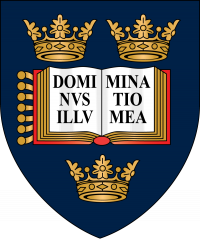Pictures of sea monsters feature on many early maps of coastal areas, seas and oceans. This is the story behind those pictures – the superstitions, the folklore beliefs and the terror of sinister creatures that mariners and explorers encountered.
A horror of sea monsters had its origins in prehistory, when the seas and oceans were teeming with fish and other creatures. It is not difficult to imagine many of the largest or grotesque ones, from whales and sharks to giant squid, being construed as threatening monsters. We cannot know to what extent the fear of sea monsters was based on real-life encounters, but it would have been intensified by finding decomposing bodies and skeletons of large marine animals washed up on the shore. In the 1970s Graham McEwan investigated sightings of sea serpents from the 18th to 20th centuries, identifying some of the species, highlighting the hoaxes and explaining how mythological characters may have been based on real creatures, even though many were by then extinct. 1
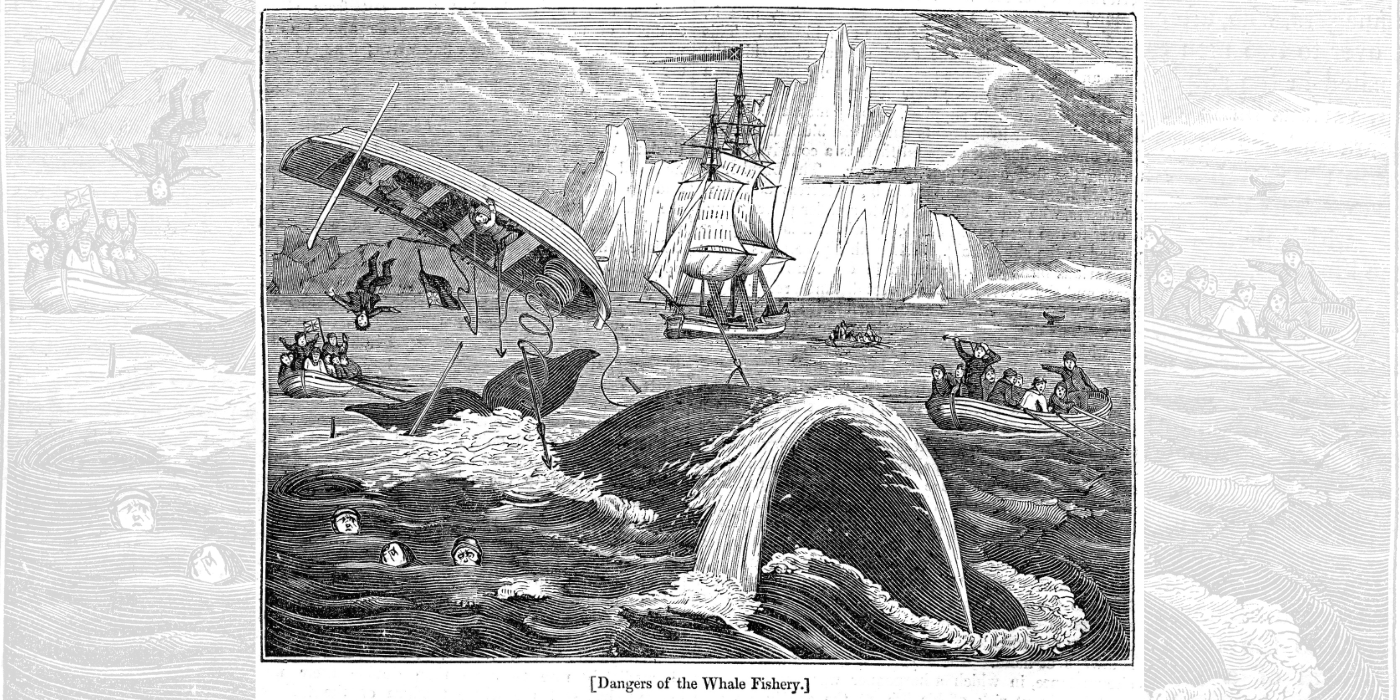
Boat capsized by whale (1833)
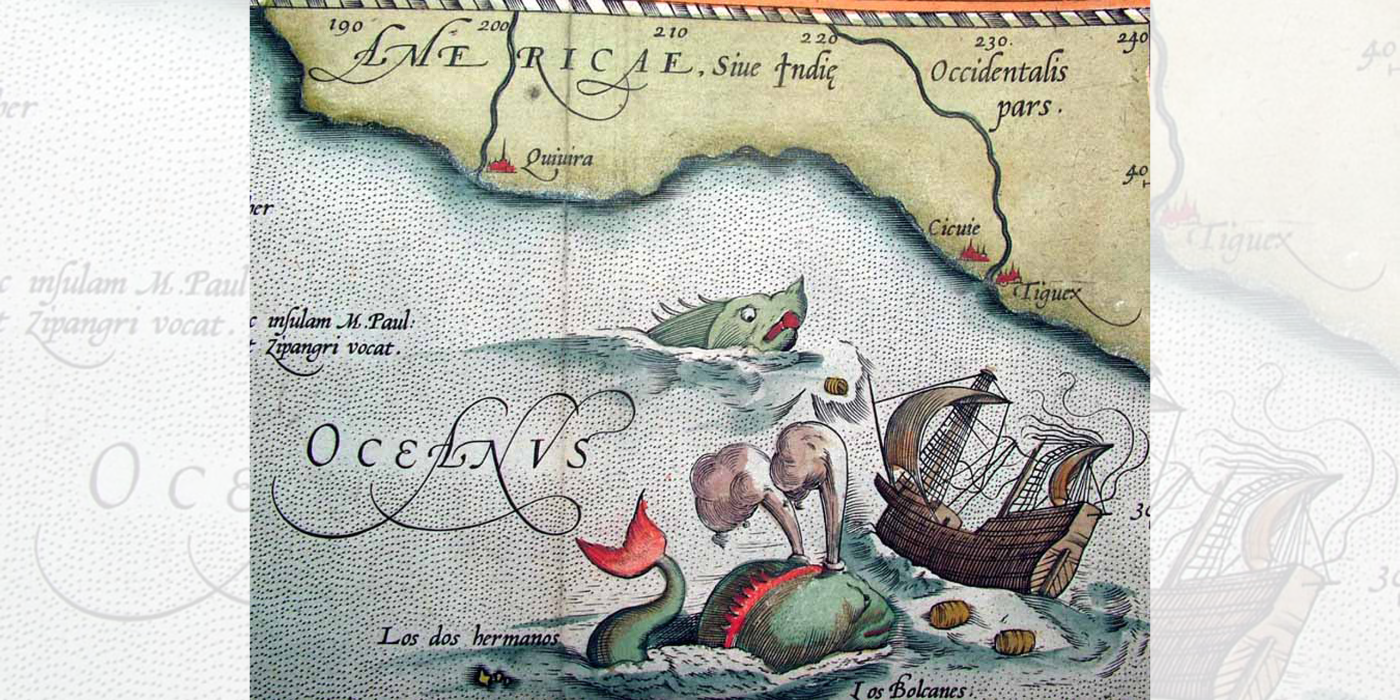
Sea monsters attacking a ship in the Pacific Ocean, 1570

Boat capsized by whale (1833)

Sea monsters attacking a ship in the Pacific Ocean, 1570
In Greek and Roman times, a period of over 1,000 years, boats and ships in the Mediterranean generally kept in sight of land. With relatively calm waters and small tidal movements, this was one of the easiest seas to navigate in summer months, but because sailing could be hazardous in winter, most craft were laid up for a few months. 2 Mediterranean mariners faced not only the dangers of weather, tides, rocks and pirates, but they also believed in all manner of imaginary beings, gods and sea monsters. By the early 5th century BC, sea monsters formed a key element of Greek legends and were subsequently incorporated into Roman myths, no doubt as a way of making sense of ominous and unsettling phenomena.
The ancient Greek word ketos (κῆτоς) was used for sea creatures such as sharks, dolphins, whales and huge fish, as well as sea monsters. It passed into the Latin language as cetus, from which is derived the modern term cetaceans, denoting whales, dolphins and porpoises.3 Scylla was supposedly a six-headed monster with a triple row of teeth and twelve feet who probably came about from sightings of squid and octopus. She inhabited the narrow Strait of Messina between southern Italy and Sicily, living off fish but also devouring men from ships that passed too close. On the opposite side of the channel was Charybdis, another female sea monster, the daughter of Poseidon and Gaia. Charybdis was like a terrifying whirlpool, sucking in seawater and ships three times a day. The legendary hero Odysseus sailed close to Scylla in order to avoid Charybdis, giving rise to the once common expression ‘between Scylla and Charybdis’ to describe an almost impossible choice of action. 4
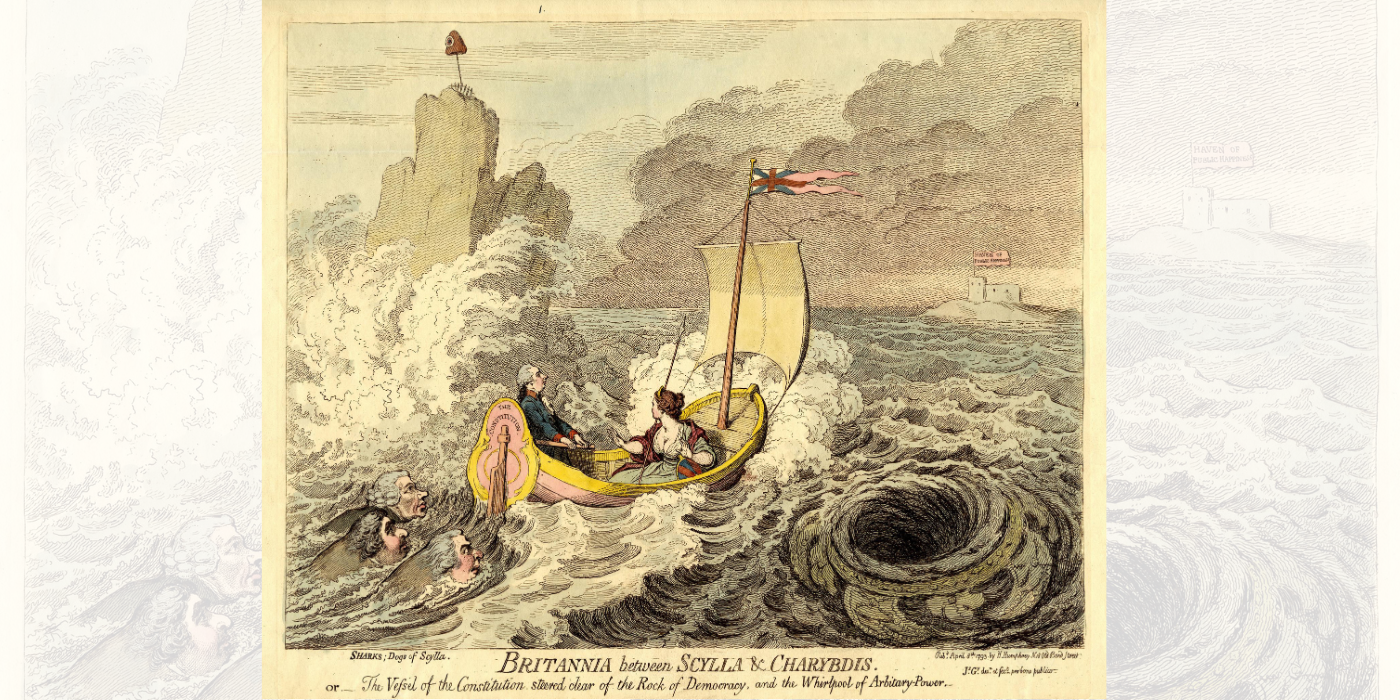
Britannia between Scylla and Charybdis
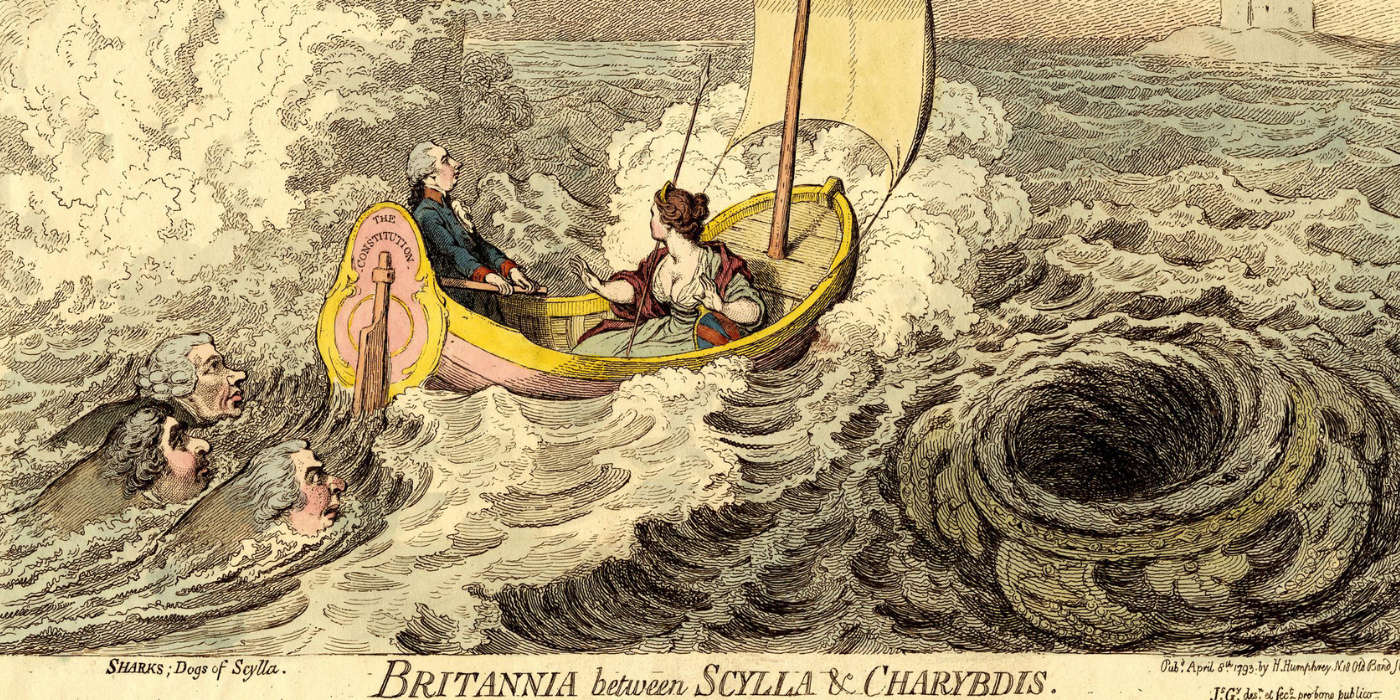
A close-up of Britannia between Scylla and Charybdis

Britannia between Scylla and Charybdis

A close-up of Britannia between Scylla and Charybdis
The sirens were mythological sea monsters in the form of half-bird and half-woman. They lived on an island close to Scylla and Charybdis and were famous for their singing, by which they lured sailors to their death. In some legends, the sirens died if any mortal escaped their clutches. Odysseus was advised to stop up his ears and those of his crew with beeswax, so they could sail past safely. However, Odysseus wanted to hear their singing and so had his crew tie him to the mast of his ship to prevent him being drawn to his death. This was a popular image in Greek and Roman art. 5
Scylla’s father was said to be Phorcys, an ancient sea god whose own parents were Pontus (the Sea) and Gaia (the Earth). Phorcys was even regarded as the father of other sea monsters, such as the Tritons. In the mid-2nd century AD, Pausanias wrote a Description of Greece, in which he mentioned seeing a dead Triton in the temple of Dionysus at Tanagra in Greece, which was missing its head. He also saw a smaller one at Rome ‘among the curiosities’:
On their heads they grow hair like that of marsh frogs not only in colour, but also in the impossibility of separating one hair from another. The rest of their body is rough with fine scales just as is the shark. Under their ears they have gills and a man’s nose; but the mouth is broader and the teeth are those of a beast. Their eyes seem to me blue, and they have hands, fingers, and nails like the shells of the murex . Under the breast and belly is a tail like a dolphin’s instead of feet. 6
Centuries later, this type of specimen with the head and trunk of a man and an aquatic tail was generally known as a ‘merman’. Mermen were sometimes shown on early maps, as were mermaids who shared the characteristics of sirens.
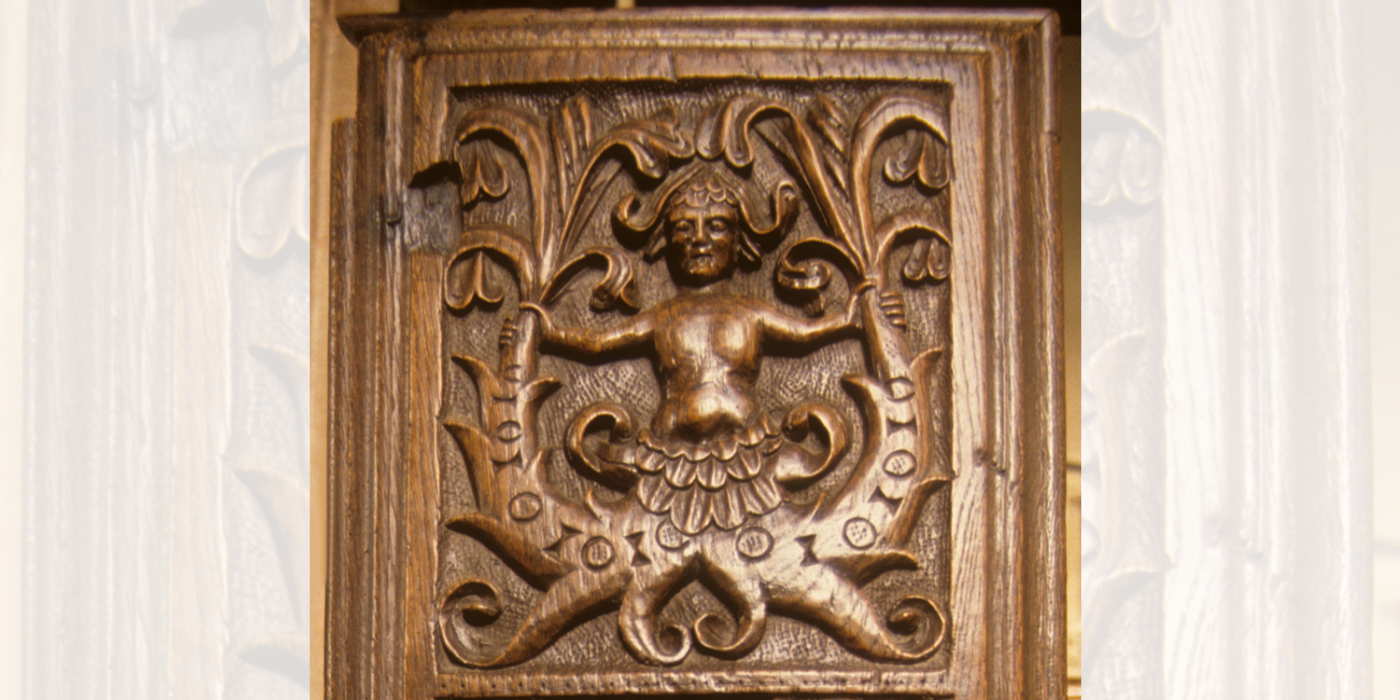
A merman on a bench end, Crowcombe, Somerset
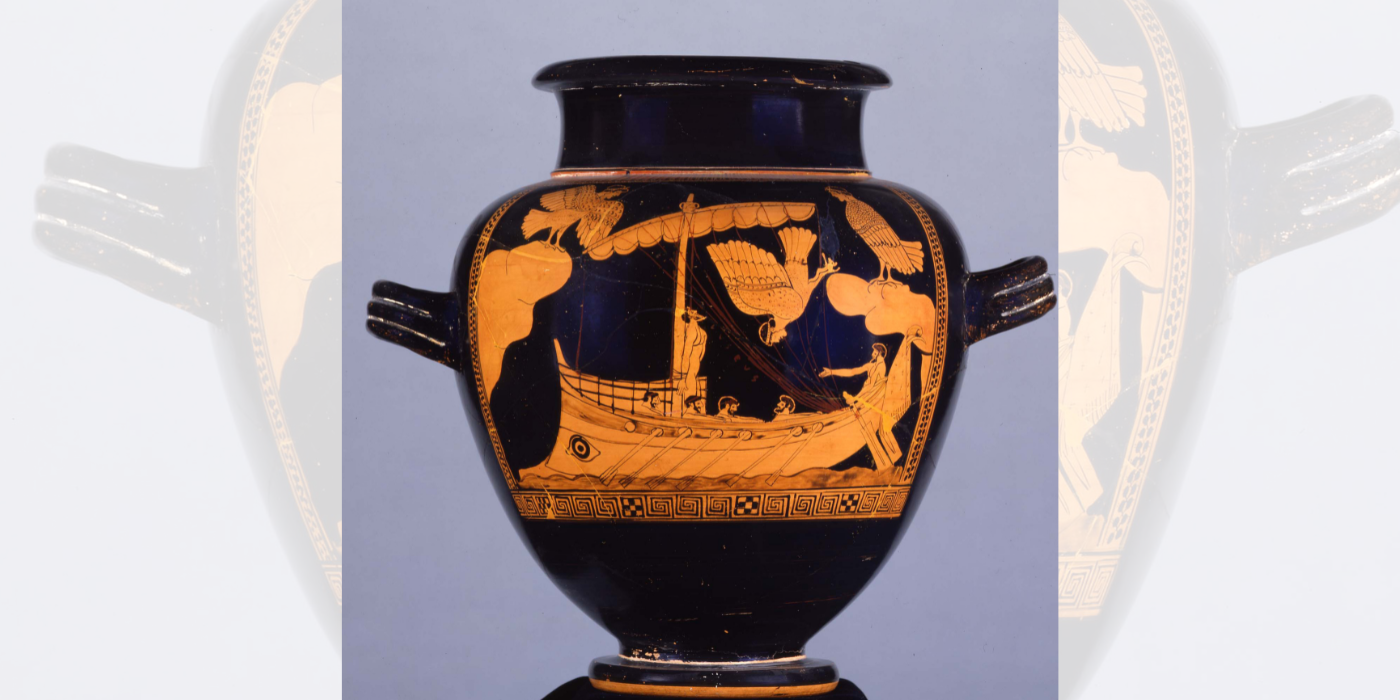
A stamnos showing Odysseus and sirens

A merman on a bench end, Crowcombe, Somerset

A stamnos showing Odysseus and sirens
To the inhabitants around the Mediterranean, the Atlantic Ocean beyond the Strait of Gibraltar was a terrifying and precarious prospect, filled with even more awful monsters. In ancient Greek times, the mythological hero and deity Hercules was said to have set up the Rock of Gibraltar (‘Calpe’) as a pillar, with Ceuta (‘Abyla’) as another pillar on the opposite African coast. In one story, Hercules cut a channel – the Straits – to separate Africa and Europe, while in another version he pulled the two continents together to prevent Atlantic monsters from bursting into the Mediterranean. 7
The Pillars of Hercules acted as a warning to sailors that they had reached the edge of civilisation, with the perilous ‘Ocean’ beyond, a vast river that encircled the earth. In the 5th century BC, the Greek poet Pindar referred to the Atlantic as ‘the trackless sea beyond the pillars of Heracles (Hercules), which that hero and god set up as far-famed witnesses of the furthest limit of voyaging. He quelled the monstrous beasts amid the seas ... and he made known the limits of the land.’ 8 The Roman historian Diodorus Siculus in the 1st century BC differed in his description:
When Heracles (Hercules) arrived at the farthest points of the continents of Libya (Africa) and Europe which lie upon the ocean ... he built out both the promontories, they say, to a great distance; consequently, whereas before that time a great space had stood between them, he now narrowed the passage, in order that by making it shallow and narrow he might prevent the great sea-monsters from passing out of the ocean into the inner sea (Mediterranean). 9
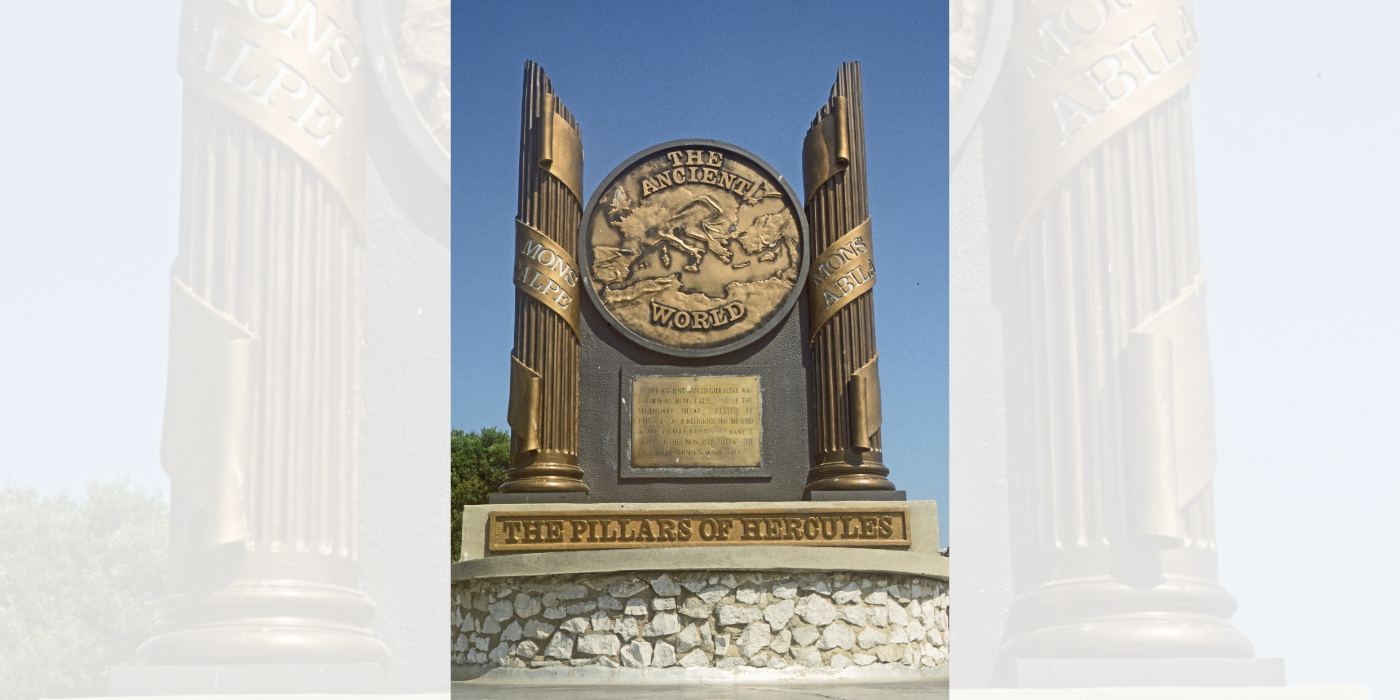
Pillars of Hercules monument, Gibraltar

Pillars of Hercules plaque, Gibraltar

Pillars of Hercules monument, Gibraltar

Pillars of Hercules plaque, Gibraltar
It was only after the Roman invasion of Britain in AD 43 and its subsequent absorption into the Roman Empire that ships began to venture out from the Mediterranean in significant numbers. Over the following centuries, as mariners journeyed even further, they met with other civilisations and sea monsters. Virtually all cultures with links to the sea have accounts of monsters, and the reports of adventurers and travellers led to cartographers placing pictures of monsters in every ocean. The exuberant phrase ‘here be monsters’ on maps and charts of the seas and oceans is rather like ‘here be treasure’ applied to remote islands or ‘here be dragons’ on land. Such words evoke danger, risk and mystery, though ‘here be monsters’ was not a feature of the earliest maps and charts. The Latin word monstra (‘monsters’) was sometimes written on medieval and Renaissance maps, but not hic sunt monstra (‘here be monsters’). Two early globes of about 1504–6 and one map of about 1460–70 do bear the similar phrase hic sunt dracones (‘here be dragons’). One of the engraved globes was formed from two lower halves of ostrich eggs, from which the other globe (the copper ‘Lenox Globe’) was cast. 10
Perhaps the closest to ‘here be monsters’ relating to the sea in medieval times is on a map of Britain by Matthew Paris, dating to about 1250. At the top, in the left-hand margin, a note in Latin can be translated as: ‘This part between the north and south (of Scotland) faces a vast sea (the Atlantic) where there is nothing except the dwelling place of monsters.’ 11
Early maps were not compiled from surveys, but from the accounts and hearsay of travellers and explorers, which is why they appear grotesquely inaccurate by comparison with modern maps. Rather than words, cartographers tended to use pictures of monsters and dragons. Their depictions of sea monsters were possibly based on sightings, though more likely they were simply a symbol of the hazards lurking in uncharted waters. From the end of the medieval period, as larger areas of the world were discovered, maps began to be based more on surveys than on stories. Cartographers moved from using monsters as warnings towards treating them as decoration, particularly to fill empty spaces and improve the design of maps. Gradually, monsters disappeared from maps altogether, though the ever-present menace of monsters in the sea remained.
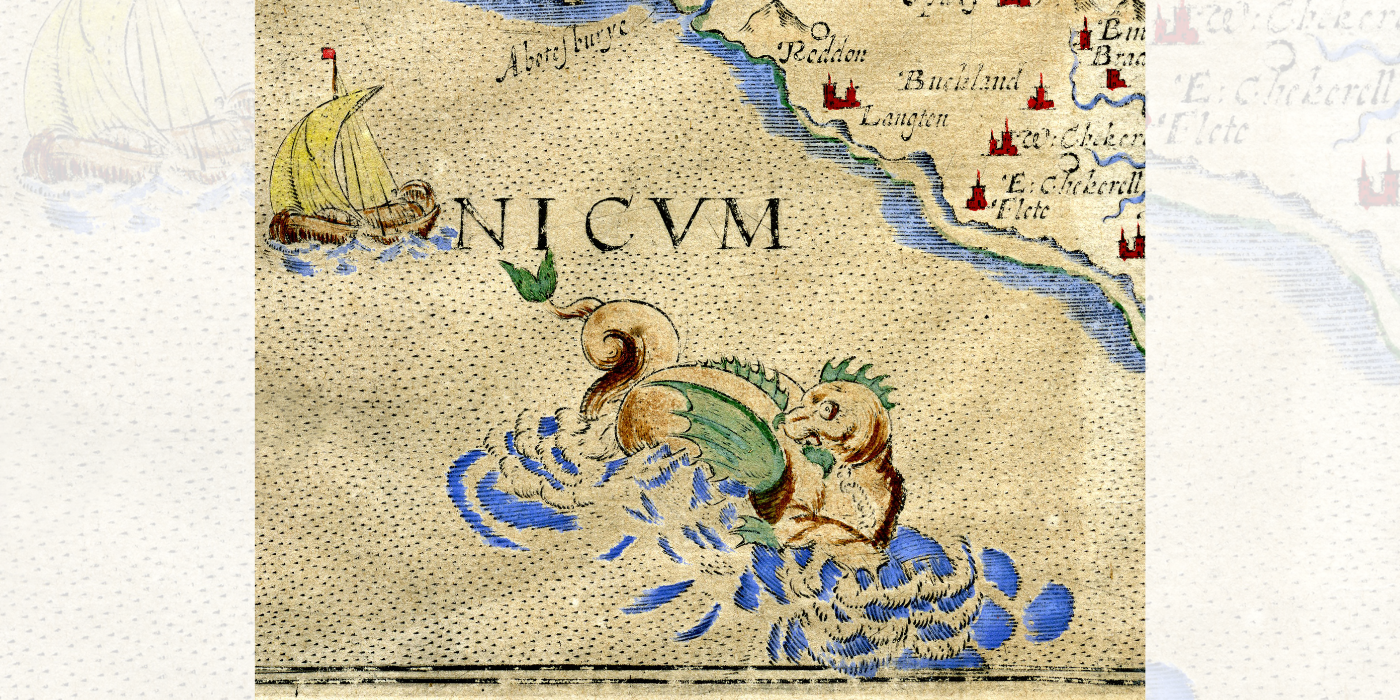
Monster on Dorset map by William Kip, 1637
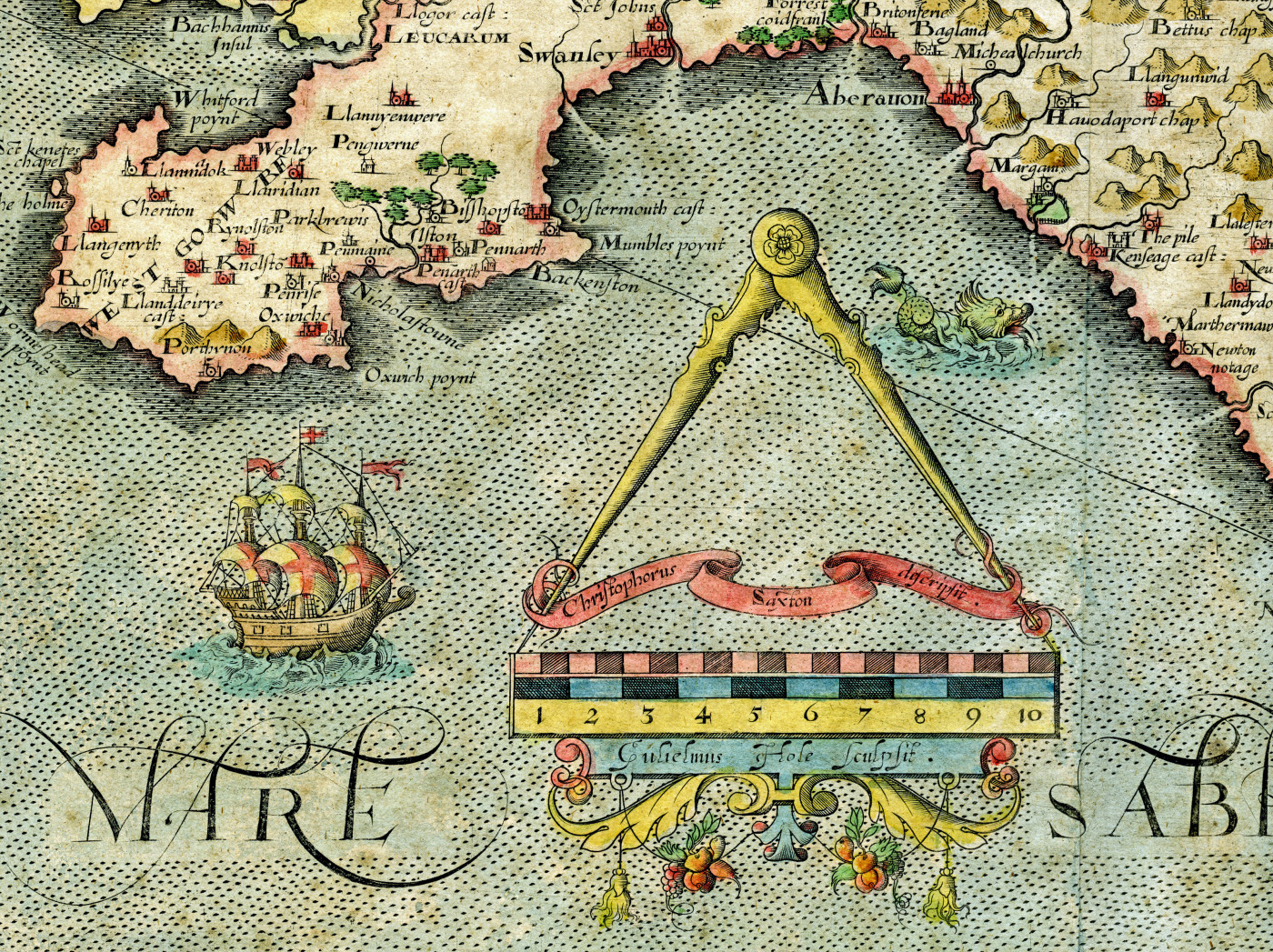
Map of Glamorgan by William Hole, 1607
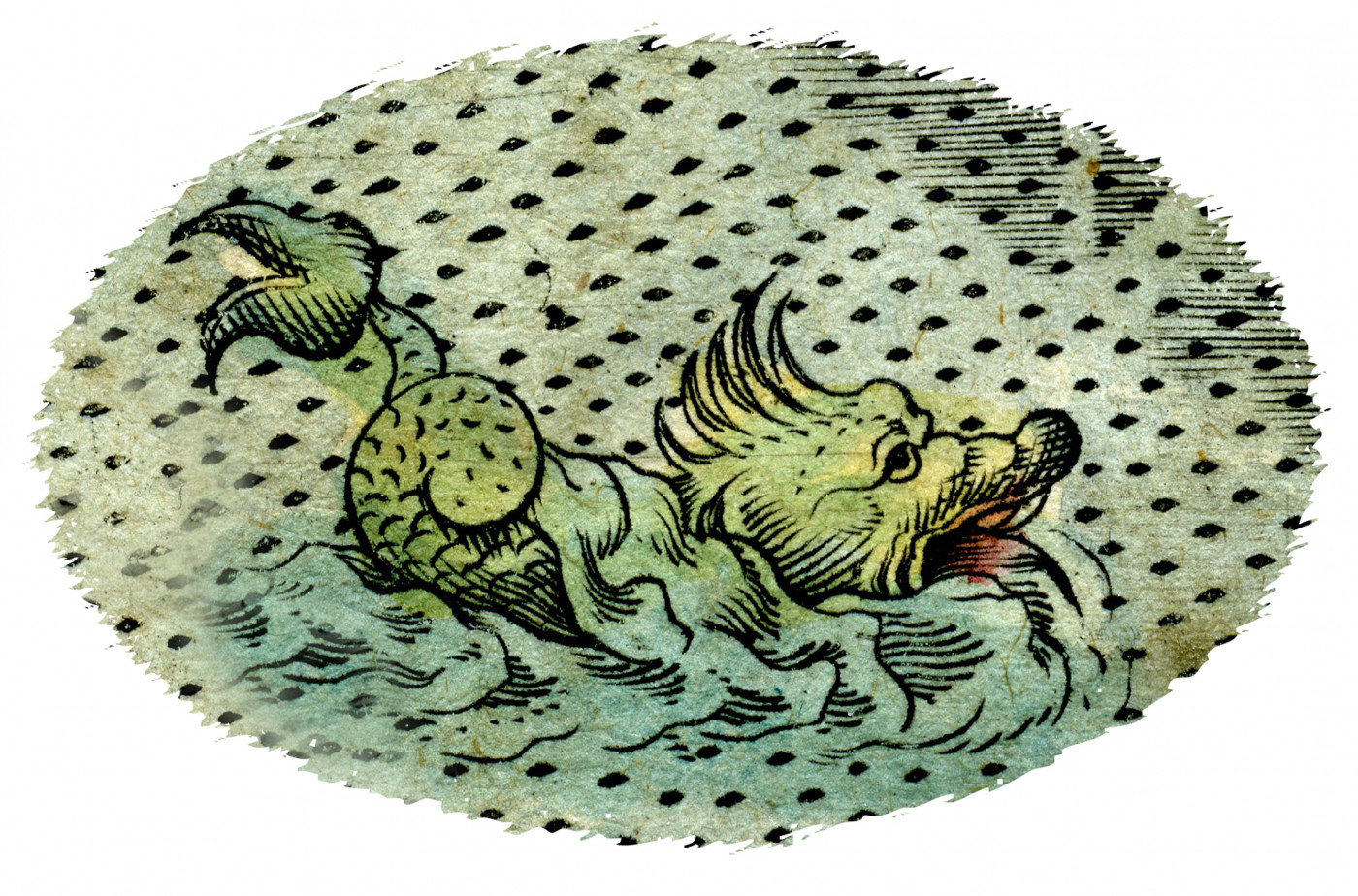
Monster vignette, Glamorgan map by William Hole, 1607

Monster on Dorset map by William Kip, 1637

Map of Glamorgan by William Hole, 1607

Monster vignette, Glamorgan map by William Hole, 1607
With increased maritime exploration and travel, encounters with sea monsters became more common, as did sightings from the shore. Newspapers relished such dramatic tales. On 14 September 1786, after a violent storm at Porthleven in Cornwall, a strange serpent was spotted still alive close to a ship that had been wrecked. The fearful inhabitants killed it, and a gentleman from the area compiled a report:
Various were the opinions about this creature; some said it was a Mermaid, others a Whale ... Its length was found to be from the top of its head to the end of its tail, 48 feet 10 inches, and its circumference in the largest part of the body 24 feet and a half. Its head was large and prickly in the hinder part ... its eyes were greenish; its mouth large; its nose flat ... No one who has seen it, knows its name, nor has any monster like it ever been described. 12
Some four decades later, on 7 February 1827, the Quebec Trader barque from Rhode Island was nearing Galway on the Atlantic seaboard of Ireland when a wreck was spotted. The master, Thomas Clearly, ordered six men to row to the hulk and board her. ‘Thomas Wilson, who was the first to board,’ he wrote in a report, ‘was instantly devoured by a most horrible animal, the like of which they had never seen or heard of.’ They were too shocked to try to catch the serpent-like beast, but instead returned to the Quebec Trader and fired a shot from a cannon, which hit the hull:
The animal raised its head, body and tail, in six or seven folds, to the height of a man each, extending itself from the tiller to the bows; its eyes were large, of a red colour, and much distorted; its throat and neck larger than any part, of a bright green hue, as were its body and sides, and the back black and scaly; it had ears or fins suspended near the head, similar to an eel, and on the nostrils a horny execrescence, blunt, and about eighteen inches long ... we consider its length to be about sixty feet, and its girth from nine to twelve feet.13
Clearly’s report was verified by the mate and two passengers, who accompanied him to the wreck after the monster ‘glided majestically into the sea’. They found no sign of Wilson, except for his hat, and concluded that the creature had been attracted to bodies on board the stricken vessel and eaten them as well.
One of the most famous sightings took place on 6 August 1848 in the South Atlantic. When the Royal Navy frigate Daedalus was sailing between the Cape of Good Hope and St Helena, an unusual animal came within 100 yards and was seen by the captain (Peter M’Quhae), the first lieutenant (Edgar Drummond), the master (William Barrett) and several crew members. In early October, the Daedalus was back at Plymouth, and reports of ‘the Great Sea Serpent’ appeared in The Times and The Illustrated London News. 14
A lively debate took place among zoologists, and a few weeks later The Zoologist journal published eyewitness accounts, along with supporting narratives of other sea monsters and arguments from sceptics about what might have been mistaken for a sea monster. One account was from Lieutenant Drummond:
In the 4 to 6 watch, at about 5 o’clock (in the afternoon), we observed a most remarkable fish on our lee quarter, crossing the stem in a S.W. direction: the appearance of its head, which, with the back fin, was the only portion of the animal visible, was long, pointed, and flattened at the top, perhaps ten feet in length, the upper jaw projecting considerably; the fin was perhaps twenty feet in the rear of the head, and visible occasionally: the captain also asserted that he saw the tail, or another fin, about the same distance behind it: the upper part of the head and shoulders appeared of a dark brown colour, and beneath the under jaw a brownish white. 15
Drummond watched the sea serpent’s progress:
It pursued a steady, undeviating course, keeping its head horizontal with the surface of the water and in rather a raised position, disappearing occasionally beneath a wave for a very brief interval, and not apparently for purposes of respiration. It was going at the rate of perhaps from twelve to fourteen miles an hour, and when nearest was perhaps one hundred yards distant: in fact it gave one quite the idea of a large snake or eel. No one in the ship has ever seen anything similar, so it is at least extraordinary. It was visible to the naked eye for five minutes, and with a glass for perhaps fifteen more. The weather was dark and squally at the time, with some sea running. 16
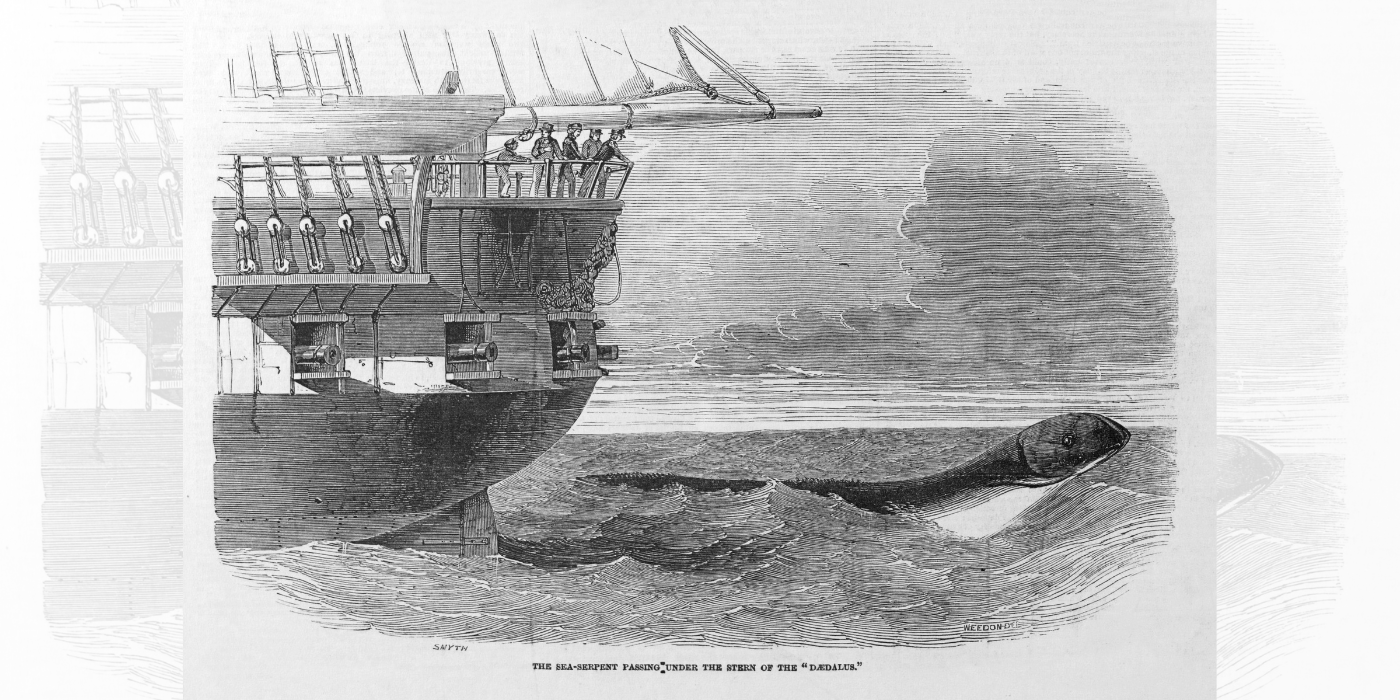
Great sea serpent, Daedalus
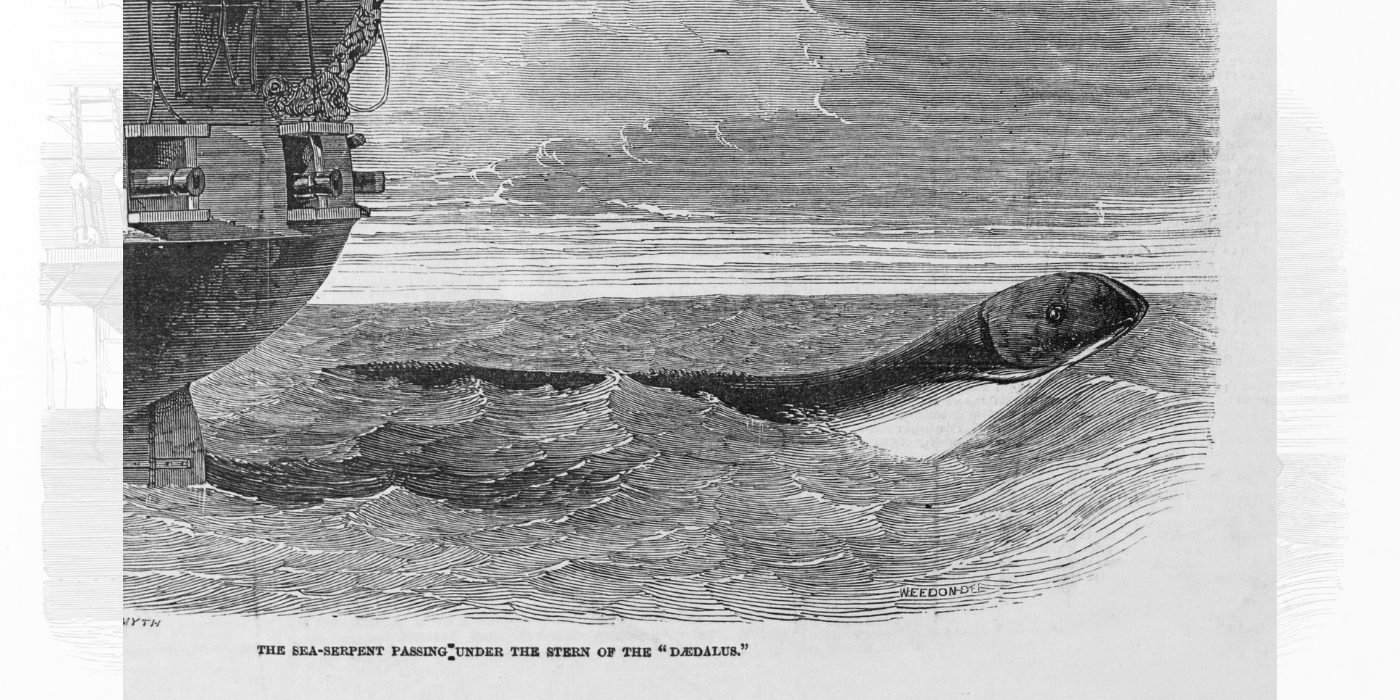
A close-up of the great sea serpent, Daedalus

Great sea serpent, Daedalus

A close-up of the great sea serpent, Daedalus
Dr Charles Cogswell, a physician and Fellow of the Linnaean Society, commented: ‘It grows more and more necessary every day to acknowledge the existence of a vast form of marine animal bearing some resemblance to a serpent.’ He took to verse to sum up his position:
The great sea-snake’s the subject of my verse:
For though mine eyes have never yet beheld him,
Nor ever shall desire the hideous sight,
Yet many accounts of men, of truth unstained,
Whose every word I firmly do believe,
Show it to be a very frightful monster. 17
Sightings of unidentified sea creatures continue today, while instances of orca whales attacking, damaging and sinking boats are on the increase, especially in the Strait of Gibraltar. This is causing alarm and anxiety, while at the same time reflecting the unease and dread felt over the millennia when venturing on the seas and faced with the unknown.
Footnotes
-
1
Graham McEwan 1978 Sea Serpents, Sailors and Sceptics (London: Routledge & Kegan Paul).
-
2
For seafaring in Greek and Roman times, see Lesley and Roy Adkins 2005 (updated edition) Handbook to Life in Ancient Greece (New York: Facts On File), pp. 214–17; Lesley and Roy Adkins 2004 (updated edition) Handbook to Life in Ancient Rome (New York: Facts On File), pp. 204–9; Simon Hornblower and Anthony Spawforth (eds) 1996 (3rd edition) The Oxford Classical Dictionary (Oxford, New York: Oxford University Press), pp. 1030–1.
-
3
Steven Ramos 2016 Sea Monsters in Ancient Greece: An Etiological and Iconographic Analysis (Undergraduate Research Thesis, Texas A&M University), pp. 2–6; John K. Papadopoulos and Deborah Ruscillo 2002 ‘A Ketos in Early Athens: An Archaeology of Whales and Sea Monsters in the Greek World’ American Journal of Archaeology 106, pp.187–227.
-
4
Jenny March 1998 Cassell Dictionary of Classical Mythology (London: Cassell), pp. 105, 352–3.
-
5
March 1998, pp. 357–8.
-
6
W.H.S. Jones (trans.) 1935 Pausanias Description of Greece, vol. 4 (Loeb Classical Library) (London: William Heinemann), pp. 259–61.
-
7
Roy and Lesley Adkins 2017 Gibraltar: The Greatest Siege in British History (London: Little, Brown), pp. 4–5.
-
8
Sir John Sandys (trans.) 1915 The Odes of Pindar including the Principal Fragments (Loeb Classical Library) (London: William Heinemann), p. 337.
-
9
C.H. Oldfather (trans.) 1935 Diodorus of Sicily in Twelve Volumes II (Loeb Classical Library) (London: William Heinemann), p. 403.
-
10
See p. 389 of Chet Van Duzer 2012 ‘Hic sunt dracones: The Geography and Cartography of Monsters’ in Asa Mittman and Peter Dendle (eds) The Ashgate Research Companion to Monsters and the Monstrous (Farnham: Ashgate), pp. 387–435; Stefaan Missinne 2013 ‘A Newly Discovered Early Sixteenth-Century Globe Engraved on an Ostrich Egg: The Earliest Surviving Globe Showing the New World’ The Portolan: Journal of the Washington Map Society 87, pp. 8–24. The ostrich egg globe came to light in 2012 and dates to about 1504. The Lenox Globe is in the New York Public Library and dates to about 1504–6.
-
11
Matthew Paris’s map of Great Britain is in the British Library, Cotton MS DVI. Van Duzer (2012), pp. 33–4 cites two similar examples on maps: ‘Three islands in which there are sea serpents twenty cubits long’ and ‘Here there are many sirens’.
-
12
Hereford Journal 12th October 1786, p. 4.
-
13
The Ariel: A Literary Gazette 1, 14th July 1827, p. 42.
-
14
The Times 10th October 1848, p. 5; The Times 14th October, p. 3; The Illustrated London News 28th October 1848, pp. 264–6. Peter M’Quhae joined the Royal Navy in 1803 as a First-Class Volunteer (see p. 708 of William R. O’Byrne 1849 A Naval Biographical Dictionary, London: John Murray).
-
15
See pp. 2306–7 of ‘The Great Sea–Serpent’ in The Zoologist 6 (1848), pp. 2306–24.McEwan 1978, p. 116, suggested it was a long-necked seal.
-
16
See p. 2307 of ‘The Great Sea–Serpent’ in The Zoologist 6 (1848), pp. 2306–24. McEwan 1978, p. 116, suggested it was a long-necked seal.
-
17
See p. 2316 of ‘The Great Sea–Serpent’ in The Zoologist 6 (1848), pp. 2306–24.




